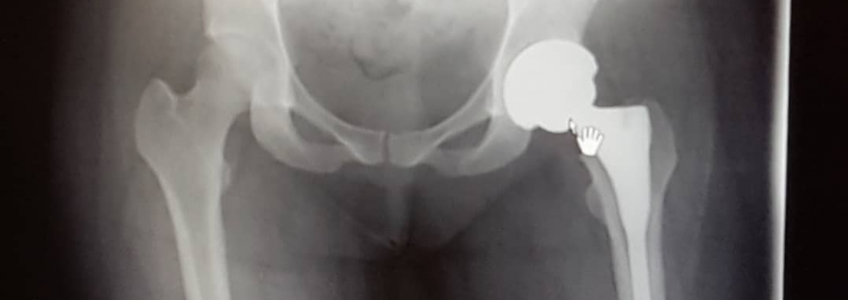
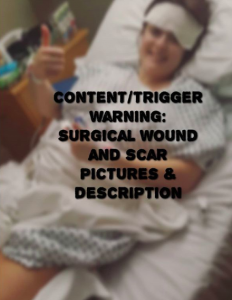
Welcome to my guide to surviving a hip replacement in your thirties (or twenties or whatever!). When preparing for my surgery I felt like there was advice out there for people significantly older than me, and looking back on my experience there are things I wish I’d known.
I should say that I am incredibly privileged to have private health insurance that covered a stay where I had my own room and I was extremely well attended to. I’m sure the experience would have been really different on a ward in an NHS hospital, but I hope the tips below will work for you wherever you’re going under the knife.
So here they are for you, along with some things that were found to be particularly useful in hospital and post surgery.
For hints and tips for preparing for surgery and things to pack, see my previous blog here.
In hospital
Everyone’s experiences in hospital will be different, and to be honest they often end up being a bit of a blur of pain meds, hospital dinners and dreaded physio visits. But here are a few things I remember and would like to pass on…

Before surgery, take time to talk to the anaesthesiologist. I arrived on the day to be told I wouldn’t be having a general anaesthetic, but an epidural and sedation instead. I was really fearful of this – would the epidural hurt? Would I wake up during surgery like I’d heard horror stories of? I really didn’t understand why they were pushing this over general anaesthetic which I’d had for all of my previous procedures. In retrospect I understand their decision. With an epidural pain signals are blocked to your brain so no part of your brain processes the trauma that’s done during surgery. This helps with those post-op blues, the grogginess that lasts for days after GA, and with pain levels (apparently with GA you unconsciously process the trauma of surgery). And they gave me a light sedation prior to the epidural so that was fine too. I wish I’d known all that before going in, but I always feel rushed with anaesthetists and end up not asking everything I want to. Also take the time to ask for everything you might need, like extra fluids. It’s much easier to advocate for yourself when you’re fully awake pre-surgery!
Be prepared for muscle spasms. No-one told me this and they are agony. I’m told it’s because I had muscle mass (specifically for me in the quad muscle) and the trauma of being in traction, of the procedure and the swelling in such a big muscle caused rolling waves of spasms that hurt like hell. It took ages to get them under control and in the end it was muscle relaxants that worked better than painkillers. So be prepared that this might happen and what to do if it does.
If you’re not already comfortable with it, get used to the idea of people seeing you naked. Not just in surgery but after. You’ll need help using the toilet and washing, and there’s no point faffing around trying to maintain your modesty. Obviously you should always do what makes you most comfortable, but doctors, nurses and healthcare assistants have literally seen it all before. I got wee on myself numerous times, and had several showers whilst in hospital, starting with cloth washes standing at the sink (which they had to do because I was leaning on the crutches) and progressing to sitting in the shower, which still requires their help for dressing and undressing. I know it’s easier said than done sometimes but it’s just going to be part of this surgery and it’s OK.
Back at home
You made it through the hospital stay and you’re back home. Hooray! Here’s some things that helped me in this next phase of recovery:
-
Put a commode in the shower – standing up is hard, add a slippery floor to the situation and it becomes downright dangerous. We found that putting a commode in the shower I could sit and wash comfortably and safely. It took some work – my mum would have to help me in there, then put the shampoo etc. in front of me on an upturned bucket so I could reach them, and then reverse the process when I was done. But it meant I could wash semi-independently and enjoy as much time under the hot water as I wanted. Bliss after the hospital!
- Have a small backpack with pain meds, a book, a battery pack & antibac wipes in – anything that helps reduce the number of journeys you need to make! The antibac wipes are great because you inevitably get your crutch handles gross, especially navigating between the toilet and sink to wash hands. Wipes were a good way of keeping the handles clean – important if your immune system isn’t in great shape.
- Borrow an arm chair – sofas are squishy and often low, and it’s easy to end up sitting in a less than ideal position post-surgery. I borrowed an arm chair from a friend and it was ideal. I could get up and down easily, my hip stayed at safe angled and the wings by the head meant I could nod off comfortably. By the end I was fighting people for space on the comfy seat!
- Do your rehab – physio exercises are notoriously boring but really do make a difference. I did them each evening before bed, adding it to my reward chart as a way to celebrate little achievements in my day/week. I also wore a pedometer and tracked my daily steps to see how I improved. I ended up only needing two physio sessions post- being an in-patient and part of that is because I actually did the exercises!
- Organise for friends and family to take you out – home gets boring quickly, so be upfront in asking your friends to pick you up and take you somewhere, even if it’s just out for a drink and a bowl of chips. I’m so grateful to the friends who kept me sane in those weeks!

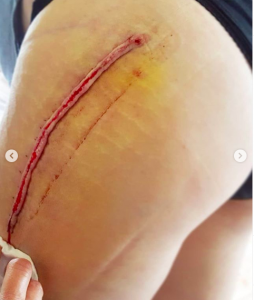
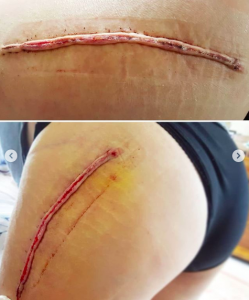
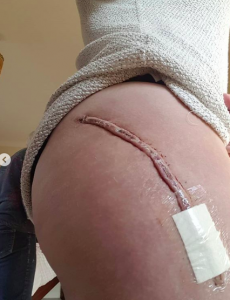
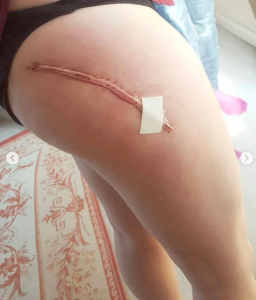
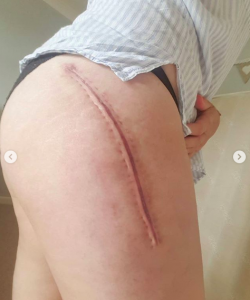
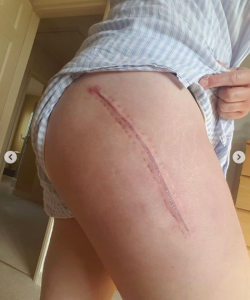

 Put a commode in the shower – standing up is hard, add a slippery floor to the situation and it becomes downright dangerous. We found that putting a commode in the shower I could sit and wash comfortably and safely. It took some work – my mum would have to help me in there, then put the shampoo etc. in front of me on an upturned bucket so I could reach them, and then reverse the process when I was done. But it meant I could wash semi-independently and enjoy as much time under the hot water as I wanted. Bliss after the hospital!
Put a commode in the shower – standing up is hard, add a slippery floor to the situation and it becomes downright dangerous. We found that putting a commode in the shower I could sit and wash comfortably and safely. It took some work – my mum would have to help me in there, then put the shampoo etc. in front of me on an upturned bucket so I could reach them, and then reverse the process when I was done. But it meant I could wash semi-independently and enjoy as much time under the hot water as I wanted. Bliss after the hospital!